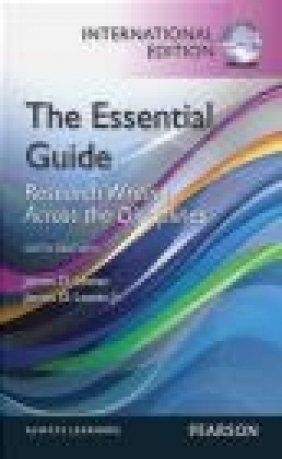Essential Guide
Jim Lester, James Lester
Essential Guide
Jim Lester, James Lester
- Producent: Pearson
- Rok produkcji: 2012
- ISBN: 9780321861290
- Ilość stron: 224
- Oprawa: Miękka
Niedostępna
Opis: Essential Guide - Jim Lester, James Lester
The Essential Guide: Writing Research Papers Across the Disciplines, based on Lester's best-selling Writing Research Papers, is the ultimate brief research reference. Pocket-sized and inexpensive, this research guide is priced to work as a supplement in any research-oriented course. Designed to be a guide for writing research papers both in first-year composition courses and in upper-level courses in all disciplines, the text features advice on the judicious handling of research materials as well as extensive coverage of electronic research. It remains rooted in the fundamentals of thorough library research but encourages and equips students to use the Internet as well as field research where appropriate. Numerous student samples and excerpts model different types of research papers from across the disciplines. Comprehensive coverage of the four most common documentation systems, reflecting the most current guidelines from both MLA and APA, increases the text's usability beyond the composition classroom.Preface Chapter 1 Writing from Research 1a Generating Ideas and Focusing the Subject Relate Your Personal Ideas to a Scholarly Problem Developing a Research Journal Asking Questions Using Key Terminology Talking with Others to Find and Refine the Topic Using Online Searches to Refine a Topic Using Textbooks and Reference Books 1b Developing a Thesis, an Enthymeme, or a Hypothesis Thesis Statement Enthymeme Hypothesis 1c Using Your Thesis to Chart the Direction of Your Research Arrangement by Issues Arrangement by Cause/Effect Arrangement by Interpretation and Evaluation Arrangement by Comparison 1d Drafting a Research Proposal Writing a Short Research Proposal Writing a Detailed Research Proposal 1e Establishing a Schedule Chapter 2 Gathering Sources in the Library 2a Launching the Library Search 2b Using the Library's Electronic Resources Catalog Books Journals Internet Sites Reference Books Archives Bibliographies 2c Searching the Library's Electronic Databases General Databases Databases by Discipline 2d Searching the Printed Bibliographies Searching in General Bibliographies Searching in the Specialized Bibliographies and Reference Works 2e Searching the Printed Indexes Starting with a General Index to Periodicals Searching Indexes to Topics in the Humanities Searching Indexes to Topics in the Social Sciences Searching Indexes to Topics in the Physical Sciences Searching Indexes to Discipline-Specific Information 2f Searching Biographies 2g Searching Newspaper Indexes 2h Searching the Indexes to Pamphlet Files 2i Searching Government Documents 2j Searching for Essays Within Books 2k Building Your Research Journal Chapter 3 Gathering Sources Online 3a Beginning an Online Search Using General Search Engines 3b Conduction Keyword and Boolean Searches 3c Using Search Engines Devoted to Academic Disciplines Humanities Social Sciences Sciences 3d Accessing Online Sources Internet Home Pages Internet Articles on the Web Journal Articles on the Web Magazine Articles on the Web News Sources Books on the Web Browsing Wikis, Blogs, Listserv, Usenent, and Chat Groups E-mail Discussion Groups Chapter 4 Conducting Field Research 4a Conducting Research Within a Discipline The Social Scientists The Physical Scientists The Applied Scientists The Humanists 4b Investigating Local Sources Interviewing Knowledgeable People Writing Letters and Corresponding by E-mail Reading Personal Papers Attending Lectures and Public Addresses Investigating Government Documents 4c Examining Audiovisual Materials, the Internet, and Television 4d Conducting a Survey with a Questionnaire 4e Conducting Experiments, Tests, and Observation Chapter 5 Understanding and Avoiding Plagiarism 5a Using Sources to Enhance Your Credibility 5b Identifying Bias in a Source 5c Honoring Property Rights 5d Avoiding Plagiarism Common Knowledge Exceptions 5e Sharing Credit in Collaborative Projects 5f Honoring and Crediting Sources in Online Classrooms 5g Seeking Permission to Publish Material on Your Website Chapter 6 Reading and Evaluating Sources 6a Selecting a Mix of Primary and Secondary Sources Guide to Academic Sources 6b Identifying Reliable Sources Scholarly Book Biography Scholarly Article Sponsored Website Interview Experiment, Test, or Observation Trade Book Encyclopedia Popular Magazine Newspapers E-mail Forum Posting Individual Website Social Media, Blogs, and Wikis Internet Chat Conversations 6c Evaluating Sources Relevance Authority Accuracy Currency Chapter 7 Organizing Ideas and Setting Goals 7a Creating Outlines Using Academic Models (Paradigms) A General, All-Purpose Model Model for the Interpretation of Literature and Other Creative Works Model for the Analysis of History Model for Advancing Philosophical and Religious Ideas Model for the Review of a Performance Model for Advancing Your Ideas and Theories Model for Argument and Persuasion Papers Model for a Comparative Study Model for a Laboratory Investigation or Field Report Model for Scientific Analysis Model for a Report of Empirical Research 7b Using Your Thesis to Control the Outline Argument Cause and Effect Evaluation Comparison 7c Writing an Outline Topic Outline Sentence Outline Chapter 8 Writing Effective Notes Honoring the Conventions of Research Style 8a Writing Personal Notes 8b Writing Direct Quotation Notes Quoting the Primary Sources Quoting the Secondary Sources 8c Writing Paraphrased Notes 8d Writing Summary Notes Using the Summary to Review Briefly an Article or Book Using the Summary to Write an Annotated Bibliography Using the Summary in a Plot Summary Note Using the Summary to Create an Abstract 8e Writing Notes from Field Research 8f Using Your Notes to Write an Annotated Bibliography 8g Using Your Notes to Write a Review of the Literature 100 Chapter 9 Drafting The Paper in an Academic Style 9a Writing for Your Field of Study Academic Style in the Humanities Academic Style in the Social Sciences Academic Style in the Physical and Medical Sciences 9b Focusing Your Argument Persuading, Inquiring, and Negotiating Maintaining a Focus with Ethical and Logical Appeals Focusing the Final Thesis Statement or Hypothesis 9c Writing an Academic Title 9d Drafting the Paper Writing with Unity and Coherence Writing in the Proper Tense Using the Language of the Discipline Using Source Material to Enhance Your Writing Writing in the Third Person Writing with the Passive Voice in an Appropriate Manner Placing Graphics Effectively in a Research Essay Avoiding Sexist and Biased Language 9e Creating an Introduction, a Body, and a Conclusion Writing the Introduction Writing the Body of the Research Paper Writing the Conclusion of the Paper 9f Revising the Rough Draft Editing Before Printing the Final Manuscript Using the Computer to Edit Your Text Participating in Peer Review Proofreading Chapter 10 Using MLA Style 10a Blending Sources into Your Writing Identifying the Author and Page Number Citing a Source When No Author Is Listed Citing Nonprint Sources That Have No Page Numbers Citing Internet Sources Citing Indirect Sources Citing Material from Textbooks and Large Anthologies Adding Information to In-text Citations 10b Punctuating Citations Properly and Consistently Indenting Long Quotations Citing Lines of Poetry Citing Drama Changing Initial Capitals Using Ellipsis Points to Omit Phrases Using Brackets to Alter Quotations 10c Writing the Works Cited References in MLA Style 136 Works Cited Form-Books Works Cited Form-Periodicals Works Cited Form-Newspapers Works Cited Form-Government Documents Works Cited Form-Internet Sources Works Cited Form-Databases Works Cited Form-Other Sources 10d Formatting the Paper in MLA Style Title Page or Opening Page Outline The Text of the Paper Content Endnotes Page Appendix Works Cited 10e Writing a Literary Paper in MLA Style Sample Research Paper Chapter 11 Writing in Apa Style 11a Meeting the Demands of the Assignment Writing Theoretical Articles Reporting on Empirical Research Reviewing Articles and Books 11b Establishing a Critical Approach 11c Writing in the Proper Tense for an APA-Styled Paper 11d Blending Sources into Your Writing Citing a Block of Material Citing a Work with More Than One Author Citing More Than One Work by an Author Citing Indirect Sources Abbreviating Corporate Authors in the Text Citing an Anonymous Author Citing Electronic Sources 11e Preparing the List of References References Form-Books References Form-Periodicals References Form-Nonprint Material References Form-Internet Sources 11f Formatting a Paper in the APA Style Title Page Abstract Text of the Paper References Appendix 11g Sample Paper in APA Style Chapter 12 The Footnote System: CMS Style 12a Blending Sources into Your Writing Introducing the Sources Inserting a Superscript Numeral in Your Text Writing Full or Abbreviated Notes 12b Formatting and Writing the Footnotes Book Journal Article Magazine Article Newspaper Article Nonprint Source: Lecture, Sermon, Speech, Oral Report Encyclopedia Government Documents Television Film on DVD Biblical Reference 12c Writing Footnotes for Electronic Sources Article Online Magazine Article Reproduced Online Journal Article Reproduced Online Article from a Database Article Accessed from a Database Through the Library System Book Online CD-ROM Source Article from an Online Service E-mail 12d Writing Subsequent Footnote References 12e Writing Endnotes Rather than Footnotes 12f Writing Content Footnotes or Content Endnotes Related Matters Not Germane to the Text Literature on a Related Topic 12g Writing a Bibliography Page for a Paper That Uses Footnotes Book Journal Article Newspaper Internet Article 12h Sample Research Paper in the CMS Style Chapter 13 CSE Style for the Natural and Applied Sciences 13a Writing In-text Citations Using the CSE Citation- Sequence System 13b Writing a Cited References Page Book Article in a Journal Internet Articles and Other Electronic Publications Magazine and Newspaper Articles Proceedings and Conference Presentations 13c Sample Paper Using the CSE Citation-Sequence System Chapter 14 Creating Electronic Research Projects 14a Beginning the Electronic Project 14b Building Electronic Presentations 14c Research Paper Web Pages and Sites Creating a Web Page Citing Your Sources in a Web Research Paper 14d Using Graphics in Your Electronic Research Paper Creating Your Own Digital Graphics 14e Delivering Your Electronic Research Paper to Readers 14f Preparing a Writing Portfolio Appendix Glossary of Manuscript Style Credits Index
Producent:
GPSR Pearson Central Europe Sp. z o.o.
ul. Szamocka 8
01-748 Warszawa (PL)
tel: 459 596 060
email: [email protected]
Szczegóły: Essential Guide - Jim Lester, James Lester
Tytuł: Essential Guide
Autor: Jim Lester, James Lester
Producent: Pearson
ISBN: 9780321861290
Rok produkcji: 2012
Ilość stron: 224
Oprawa: Miękka
Waga: 0.24 kg






























